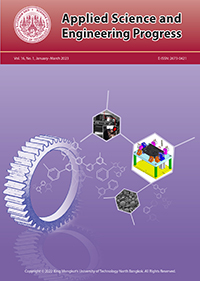Optimization of Design for Air Gap Sensor Using the Response Surface Methodology
Main Article Content
Abstract
In Hard Disk Drive (HDD) manufacturing, there is always a concern about the cutting defects that are caused by residual cutting chips. Only a small amount of 10 μm chips (act as the air gap) can cause the workpiece to tilt and shift from the correct position, and thus affect the dimension of the workpiece (mainly the Base HDD). For this reason, researchers adapted the adjustable micrometer as a simulation device that resembles the air gap for the design of the Air Gap Sensor Module. The design of experiments using response surface methodology will be studied to confirm the appropriate factors of the prototype. This study reports the optimization of the main factors that affect Air Gap Sensor Module condition: Air Nozzle Diameter 2.303 mm, Air Pressure 0.1 MPa, and Sampling Time 645 ms, which has a high square of the coefficient correlation (R-squared = 99.0%) with a close relationship between gap distance and air pressure. The relationship between these variables is mostly linear. The R-squared error percentage of actual value is less than 0.93% compared to predicted value. The mathematical model results and experimental values were consistent and able to predict response variables. The Air Gap Sensor Module can provide the measurement results in micron accuracy and displays light and beep to confirm as acceptable or reject gap conditions with the uncertainty of measurement ± 0.001 mm.
Article Details
References
M. Dechape, The Principles and Applications of Pneumatic Gauging, 2nd ed. Michigan: Society of Manufacturing Engineers, 1983, pp. 88–94.
S. Laosakulthai, “Design and development of prototype air gauge for non-contacting length measurement optimization,” M.S. thisis, Faculty of Engineering, King Mongkut’s University of Technology North Bangkok, Bangkok, 2015.
M. Rucki, B. Barisic, and T. Szalay, Analysis of Air Gage Inaccuracy Causes by Flow Instability. Amsterdam, Netherlands: Elsevier, 2000, pp. 655–661.
M. Jukubowicz, “Accuracy of roundness assessment using air gauge with slot-shaped measuring nozzle,” Measurement, vol. 155, 2020, Art. no. 107558.
C. J. Jermak and M. Rucki, “Influence of geometry of the flapper – Nozzle area in the air gauge on its metrological properties,” in 8th International Symposium on Measurement and Quality Control in Production, 2004, pp. 385–393.
U. N. Wanasundara and F. Shahidi, “Concentration of omega 3-polyunsaturated fatty acids of seal blubber oil by urea complexation: Optimization of reaction conditions,” Food Chemistry, vol. 65, pp. 41–49, 1999.
Y. N. Lye, N. Salih, and J. Salimon, “Optimization of partial epoxidation on jatropha curcas oil based methyl linoleate using urea-hydrogen peroxide and methyltrioxorhenium catalyst,” Applied Science and Engineering Progress, vol. 14, no. 1, pp. 88–99, 2021, doi: 10.14416/j.asep. 2020.12.006.
M. Bahadi, N. Salih, and J. Salimon, “D-optimal design optimization for the separation of oleic acid from malasian high free fatty acid crude plam oil fatty acids mixture using complex fractionation,” Applied Science and Engineering Progress, vol.1 4, no. 2, pp. 175–186, 2021, doi: 10.14416/j.asep.2021.03.004.
A. Hamisu and U. I. Gaya, “Bi-template assisted sol-gel synthesis of photocatalytically-active mesporous anatase TiO2 nanoparticles,” Applied Science and Engineering Progress, vol. 14, no. 3, pp. 313–327, 2021, doi: 10.14416/j.asep.2021.04.003.
M. Dechape, “Pneumatic gauging system A.K.A. air gauging system A.K.A. air electric converter,” U.S. Patent 7 694 549 B2, 2010.
P. Pongdang, “Improvement of pivot assembly process using response surface methodology,” M.S. thesis, Faculty of Engineering, Thammasat University, Bangkok, 2018.
Slim Pressure Sensor Model, Omron E8EB-01C, 2021.
Digital Pressure Switch Model, SMC ISE40-01- 22-M, 2021.
A. Menon, “Linear Regression Using Least Squares,” 2018. [Online]. Available: https:// towardsdatascience.com/linear-regression-usingleast- squares -a4c3456e8570.
R. Gunesh, “Correlation Analysis,” 2020. [Online]. Available: https://www.rajgunesh.com/resources/downloads/statistics/pearsoncorrel.pdf
Micro controller Board, “Analog to Digital Converter tutorial,” 2020. [Online]. Available: http://www.microcontrollerboard.com/analogto- digital-converter.
Custom Control Sensors, “What’s the Difference Between a Pressure Switch and Sensor,” 2014. [Online]. Available: https://www.ccsdualsnap. com/pressure-switches-vs-pressure transmitters.
RS Components, “Pressure Gauge Type,” 2020. [Online]. Available: https://th.rs-online.com/web/c/ pneumatics-hydraulics/pneumatic-hydraulicpressure- gauges/pressure-gauges/
D. C. Montgomery, Design and Analysis of Experiments, 8th ed. New York: John Wiley & Sons, 2012.
B. F. Ryan, B. L. Joiner, and J. D. Cryer, MINITAB Handbook Update for Release 16, 6th ed. California: Brooks/Cole Publishing Co., 2010.
J. Deeying, “Optimization of process parameters in lead-free solder jet bonding using laser to increase the shear strength of solder joint in HGA,” Ph.D. dissertation, Faculty of Engineering, King Mongkut’s University of Technology North Bangkok, Bangkok, 2019.
S. Pumkrachang, “Multi - objective optimization of UV spot curing technique of slider suspension attachment process using response surface methodology,” Ph.D. dissertation, Faculty of Engineering, King Mongkut’s University of Technology North Bangkok, Bangkok, 2021.
J. Arnthong, “Optimization of glucoamylase production by a thermotolerant Rhizopus microsporus TISTR 3518 using response surface methodology,” in 47th Kasetsart University Annual Conference, 2018, 112–121.
B. Durakovic, “Design of experiments application, concepts, examples: State of the art,” Periodicals of Engineering and Natural Scinces, vol. 5, no. 3, pp. 421–439, 2017.
S. Bell, Measurement Good Practice Guide No.11 (Issue 2) A Beginner’s Guide to Uncertainty of Measurement. London, UK: The National Physical Laboratory, 2001.


